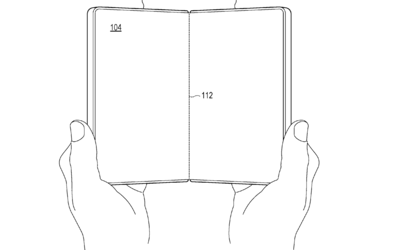Microsoft is reportedly exploring a return to the foldable device market after the discontinuation of its Surface Duo line. A recent patent application suggests the tech giant is developing a novel hinge mechanism aimed at improving the durability and aesthetics of foldable smartphones.

The patent, filed on February 29th with the United States Patent and Trademark Office, details a "spine cover plate" designed to protect the device's single hinge system. This technology could potentially position Microsoft to compete with devices like the Samsung Galaxy Z Fold.
The application describes a device featuring a flexible display in a book-style design, similar to the Galaxy Z Fold. The core innovation lies in the spine cover plate mechanism, which aims to safeguard the single-hinge system by encasing the structural element.
The key differentiator between conventional hinges and Microsoft's design is the automatic adjustment of the spine cover during opening and closing. This aims to eliminate gaps around the hinge, thus protecting it from dust and water. Currently, Samsung's foldable design offers an IPX8 rating, which only provides water resistance.
According to the patent, this new hinge mechanism could also allow Microsoft to minimize the hinge crease, making it less visible than current solutions on the market.
Furthermore, Microsoft outlines methods to reduce the overall thickness of the foldable smartphone. By enabling the spine cover plate to move closer to the device's hinge when folded, the device would be more ergonomic.
"By retracting the spine cover plate toward the central spine as the first display-supporting frame and the second display-supporting frame are rotated into a face-to-face orientation, the width of the folded computing device is reduced, thereby enabling easier and more comfortable handling of the device, such as with one hand," the patent states.
The smartphone industry is actively seeking ways to eliminate the crease inherent in foldable displays. While some manufacturers have implemented water-drop folding mechanisms to mitigate the issue, a truly crease-free foldable remains elusive. The durability of these devices, given their numerous moving parts, is also a significant consideration.
Adding another layer, especially a movable one, to the already complex foldable mechanism raises questions about practicality, despite the potential benefits and enhanced durability outlined in Microsoft's patent application.
Newer articles
Older articles
 Wimbledon’s youthful buzz: Smelling of teen spirit ahead of the Championships
Wimbledon’s youthful buzz: Smelling of teen spirit ahead of the Championships
 Nitish Rana Set for Delhi Return After Disappointing Uttar Pradesh Stint
Nitish Rana Set for Delhi Return After Disappointing Uttar Pradesh Stint
 Chess Sensation Praggnanandhaa Joins Magnus Carlsen's Team Liquid Ahead of Esports World Cup
Chess Sensation Praggnanandhaa Joins Magnus Carlsen's Team Liquid Ahead of Esports World Cup
 Gavaskar Calls for Kuldeep Yadav Inclusion in Second Test Amid Bumrah Fitness Concerns
Gavaskar Calls for Kuldeep Yadav Inclusion in Second Test Amid Bumrah Fitness Concerns
 Bennett to take no further part in SA Test, Masvaure named concussion substitute
Bennett to take no further part in SA Test, Masvaure named concussion substitute
 Stokes Lauds England's Opening Duo After Stunning Headingley Chase Against India
Stokes Lauds England's Opening Duo After Stunning Headingley Chase Against India
 Rishabh Pant Redefining Cricket: Greg Chappell Hails Wicketkeeper-Batter as a "Match-Winner"
Rishabh Pant Redefining Cricket: Greg Chappell Hails Wicketkeeper-Batter as a "Match-Winner"
 Nitish Rana Eyes Delhi Return After Disappointing Uttar Pradesh Stint
Nitish Rana Eyes Delhi Return After Disappointing Uttar Pradesh Stint
 India Squad Update: Harshit Rana Released Ahead of Second Test Against England in Birmingham
India Squad Update: Harshit Rana Released Ahead of Second Test Against England in Birmingham
 Steve Smith Eyes Grenada Test Return After Finger Injury
Steve Smith Eyes Grenada Test Return After Finger Injury